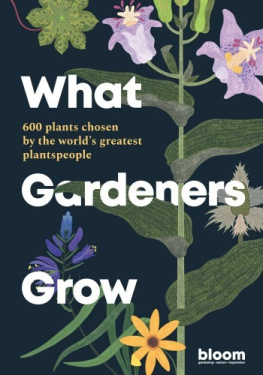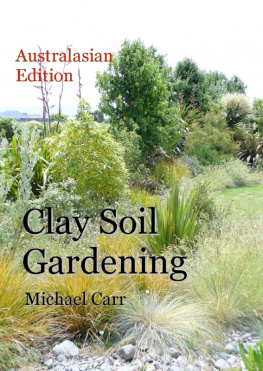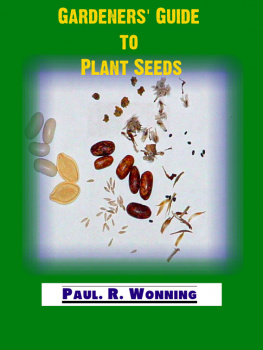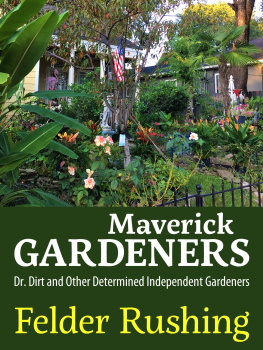
The Southern Gardeners
BOOK OF LISTS
The Best Plants for
All Your Needs, Wants,
and Whims

LOIS TRIGG CHAPLIN

To Van
Copyright 1994 by Lois Trigg Chaplin
All rights reserved.
No part of this book may be reproduced in any form
without written permission from the publisher.
TAYLOR TRADE PUBLISHING
An Imprint of the Rowman & Littlefield Publishing Group
4501 Forbes Boulevard, Suite 200
Lanham, MD 20706
Distributed by National Book Network
Designed by David Timmons
Illustrations by Georgene Wood
Library of Congress Cataloging-in-Publication Data
Chaplin, Lois Trigg.
The southern gardeners book of lists : the best plants for all
your needs, wants, and whims / Lois Trigg Chaplin.
p. cm.
Includes bibliographical references, index.
ISBN: 978-0-87833-844-3
1. Landscape plantsSouthern States. 2. Landscape gardeningSouthern States. I. Title.
SB407.C443 1994 |
635.90975dc20 | 93-44529 |
CIP |
Printed in the United States of America

CONTENTS
ACKNOWLEDGMENTS
Many gardeners and plant professionals gave their time and expertise to help me compile these lists. Thanks to all of you for your sharing spirit. I also want to thank Linda Askey and Judy Lowe for their generous help with so many lists and rosarian Liz Druitt for the excellent lists on roses. Thanks also to Glenn Morris; without his help on trees and shrubs this manuscript might still be on my desk.
A LETTER TO THE READERS
Dear Southern Gardeners,

For years Ive wanted to write a book to help Southerners who want to improve their landscapes but have no shopping list. With this book I hope you will be able to put together a list of possible plants for your landscape, and then learn more about them by reading other books and contacting local resources, such as Master Gardeners, botanical societies, and retail garden centers. And while no one becomes a gardener by reading a bookyou have to do itthis book can help you sort the plants and related information so you wont feel like an earthworm in an ant bed when you get out youll find everything simply explained.
If youre new to gardening, new to the South, or a seasoned gardener looking for more, this book is for you. It encompasses the knowledge and experiences of dozens of gardeners and professionals. Yet, no single text can possibly give every detail on every plant, and there are better people than me to write about those things. So I recommend several books (listed on ) as companions to this one. Most of these arent books youre likely to find in every bookstore. They dont wow potential buyers with romantic photos of English gardens, so many bookstores dont carry them. But theyre packed with information that does apply to the South, and if I could afford it Id have a case of each in the back of my van to give those who seek my advice. When youre in the garden business everybody asks you plant questionsat the ballpark, in the grocery line, at parties... everywhere. My OB even tried to talk wildflowers during labor. All this tells me one thingthere is great interest out there, but not enough straightforward information. Thus the reason for this book. I hope it helps you.
Happy gardening,


DONT SKIP THIS INTRODUCTION
An introduction seems like the very first thing an author would write, but in reality it is the last. This is my chance to tell you a little bit about the philosophy of the book and give you a road map for going through it. And that is best done when every detail is known. So, please read on and youll know how to approach the information in the book.
ITS A NOTEBOOK
Feel free to add to the lists (or scratch through them) and make notes wherever you need to. From the beginning, I intended for The Southern Gardeners Book of Lists to function as a workbook, and I hope it becomes a garden planner and notebook as well as a resource.
WHAT A DIFFERENCE THE SOIL MAKES
Soil makes as much difference in a plants ability to grow in your locale as the climate does. However, it would be a life-long task to classify plants and key them to a map based on soil type, so Im afraid that all of us are still on our own. Always ask about how a plant will do in sandy clay or alkaline soil or whatever you have. Here are some examples of what youll run into: Azaleas are hardy in the Mid-South, which stretches from Baltimore to Dallas, but its much harder to grow them in Dallas because the soil is alkaline and azaleas like it acid. Some plants that will grow in the sandy soil of North Florida might struggle in the gumbo clay of South Louisiana or the Yazoo clay of Jackson, Mississippi, even though the climates of these three places dont differ greatly. So, always use the regions given in this book and elsewhere only as a general guideline. Ask questions locally about the plants that interest you.
NEW AND OLD NAMES
Some of the scientific names listed might not be the latest ones, because plant taxonomists continuously rename and re-categorize plants and then publish their results every generation or so in a 1,300-page, $150-plus book called Hortus. Each time this happens, it forces all of us in horticulture have to scramble to get it for fear that we might use the archaic lingo. All this renaming is necessary to taxonomy, but it sure makes for a lot of frustration on our end. For example, climbing hydrangea has been known as Hydrangea petiolaris for decades, and often is still listed that way in nursery industry catalogs, even though the name has officially changed to Hydrangea anomela subspecies petiolaris. Got it? Well, dont worry, here I stuck to the old name. In another case, Zinnia linniaris, a popular creeping annual, was changed to Zinnia angustifolia. In this case Ive used the new name because Ive seen it in practical use more. Ive made many such judgment calls throughout the book, so if you ask for a plant that your nurseryman knows by a different name, be aware that you could both still be talking about the same one. Such is the world of horticulture.
VARIETIES, CULTIVARS, OR SELECTIONS?
Some plant professionals and taxonomists might take me to task about the loose use of the word variety in this book. Yet this is an area of confusion even for the professionals, so I certainly dont want homeowners to have to worry about it. For simplicitys sake, Ive used the terms variety, cultivar, and selection interchangeably in this book, although scientifically there are differences. The important thing is that you remember the name of the plant so your local nursery or designer will know what you are talking about.
Next page










